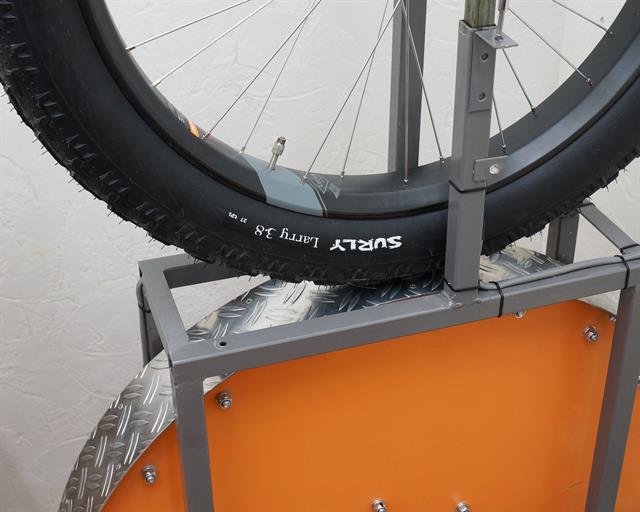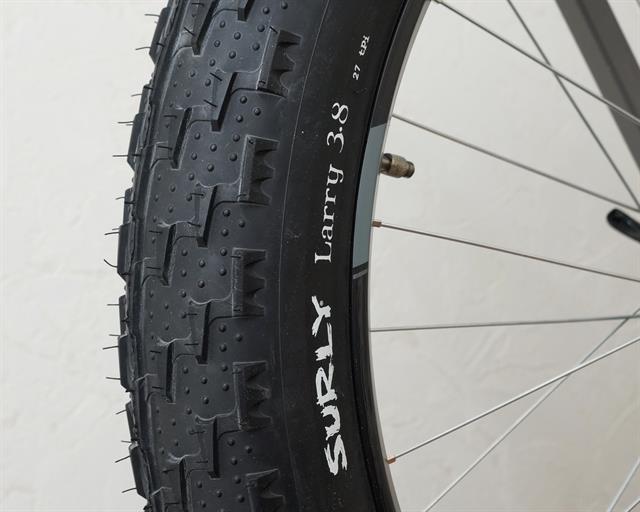Fat Bike Tire Test: Surly Larry 27 TPI
Contents and Test Summary
- Introduction
- Manufacturer Specifications
- Size, Weight, Thickness
- Rolling Resistance: 38.0 Watts
- Puncture Resistance: 28 Points
- Conclusion: 2 / 5 Not Recommended
- Comments
- Surly Larry 27 TPI
(100% is fastest - lightest - highest - strongest)

The Surly Larry is available in both a folding bead 120 TPI and a wire bead 27 TPI version. Because the price difference between these versions is quite large, it's interesting to compare both and see how much you're losing when going with the cheaper version. When looking at the specifications of both the 120 TPI and 27 TPI versions, the most obvious difference is the much higher weight of the cheaper version: 1567 grams Vs 1256 grams.
Except for the much higher weight of the 27 TPI version, both versions appear to be identical when fitted to the bike. The only thing that makes it clear you're running the 27 TPI version is the small "27 tpi" printing on the sidewalls of the tires. Unfortunately, Surly doesn't give a lot of technical details about their tires. I couldn't find any info about the compounds used on these tires, so I'm not sure if the differences seen in the tests come from the casing or the compound.
Manufacturer Specifications
| Manufacturer Specifications | |
|---|---|
| Brand | Surly |
| Model | Larry 27 TPI |
| Year | 2016 |
| Supplied By | Bought in store |
| New or Used | New |
| Mileage | 0 km |
| Price Range | High |
| Buy At | |
| Manufacturer part number | |
| TPI | 27 |
| Compound | |
| Bead | Wire |
| ETRTO | |
| Size Inch | 26" |
| Width Inch | 3.80 |
| Specified Weight | 1567 grams |
| Max Air Pressure (psi) | 30 |
| Made In | Pro Data |
| Available Sizes | 26x3.80 |
Surly Larry 27 TPI Test Results

Size, Weight, and Thickness Measurements
| Size, Weight, and Thickness Measurements | |
|---|---|
| Specified Weight | 1567 grams |
| Measured Weight | 1660 grams |
| Measured Width Carcass | 95 mm (un-round) |
| Measured Width Tread | 92 mm |
| Measured Height | Pro Data |
| Tire Circumference | Pro Data |
| Measured Knob Height Center | 4.5 mm |
| Measured Knob Height Edge | 4.5 mm |
| Measured Total Thickness Center (excluding knobs) | 2.90 mm |
| Measured Total Thickness Sidewall | Pro Data |
| All size measurements are taken at an air pressure of 16 psi / 1.1 bars on a 65 mm inner width rim. | |
As mentioned before, the biggest difference is the much higher weight of the 27 TPI version. After measuring both tires, the difference is even bigger as my sample of the 120 TPI version came in below the specified weight and the 27 TPI version came in quite bit heavier than the specified weight: 1660 grams Vs 1567 grams. When fitting both the 120 TPI and 27 TPI version on a 65 C rim, inflated to 16psi, the 27 TPI version ends up slightly bigger with a max casing width and height of 95 and 81 mm (the 120 TPI Larry came in at 93 and 80 mm).
After measuring the thickness of the casing of both tires, it becomes clear why the 27 TPI carries that much more weight: the sidewalls and tread section of the 27 TPI Larry are much thicker. The sidewalls of the 27 TPI version have a thickness of 1.3 mm (120 TPI = 0.9 mm). The tread section of the tire has a thickness of 2.9 mm (120 TPI = 2.5 mm). The height of the knobs is the same for both the 27 and 120 TPI versions.
Rolling Resistance Test Results
| Rolling Resistance Test Results | |
|---|---|
| Inner Tube | None (60 ml sealant) |
| Rolling Resistance 20 PSI / 1.4 Bar | Pro Data |
| Rolling Resistance 16 PSI / 1.1 Bar | Pro Data |
| Rolling Resistance 12 PSI / 0.8 Bar |
38.0 Watts CRR: 0.01139 |
| Rolling Resistance 8 PSI / 0.6 Bar | Pro Data |
| All numbers are for a single tire at a speed of 29 km/h / 18 mph and a load of 42.5 kg / 94 lbs. Use the formula: RR (Watts) = CRR * speed (m/s) * load (N) to calculate rolling resistance at a given speed and load. |
|
As expected, the 27 TPI version has a higher rolling resistance than the more expensive and lighter 120 TPI Larry (read review), but the disadvantage isn't as big as I had expected. On average, it appears rolling resistance of the 27 TPI Larry is close to 10 - 15 % higher across the different air pressures.
While rolling resistance isn't that much higher than the 120 TPI Larry, it must be said the 120 TPI Larry didn't perform that well in the rolling resistance test in the first place. When comparing the 27 TPI Larry with the much faster Schwalbe Jumbo Jim, rolling resistance is close to 50% higher.
Puncture Resistance Test Results

| Puncture Resistance Test Results (higher is better) | |
|---|---|
| Total Puncture Score Tread | 28 Points |
| Total Puncture Score Sidewall | Pro Data |
| Tread Puncture Force Sharp Needle | 5 Points |
| Tread Puncture Force Blunt Needle | Pro Data |
| Tread Total Tire Thickness | 2.90 mm |
| Sidewall Puncture Force Sharp Needle | Pro Data |
| Sidewall Puncture Force Blunt Needle | Pro Data |
| Sidewall Total Tire Thickness | Pro Data |
In the puncture resistance tests, the 27 TPI Larry scores nearly the same as the 120 TPI Larry in both the tread and sidewall tests.
Conclusion
- Surly Larry 27 TPI
(100% is fastest - lightest - highest - strongest)
Just like the 120 TPI version of the Larry, I'm not impressed by this cheaper 27 TPI version. Weight is way too high for me to consider this tire and to make matters worse, comes in over the specified weight by nearly 100 grams. I can't recommend this tire because even though this is a cheaper alternative to the 120 TPI Larry, it's more expensive than other top of the line, better performing tires from other manufacturers.
If you want to compare all data of the 27 TPI and 120 TPI Larry side by side, go here: Larry 120 TPI Vs Larry 27 TPI side by side comparison Take a look at the fat bike overview page to see which tires perform better on our tests.
RATING:
2
/ 5
TEST VERDICT:
Not Recommended
